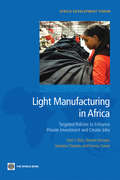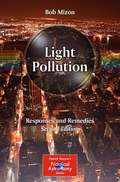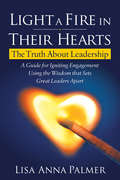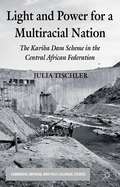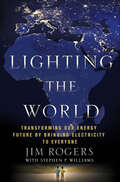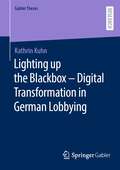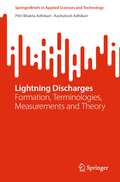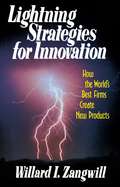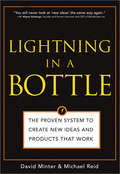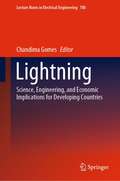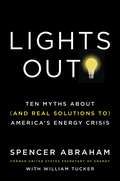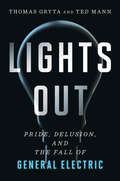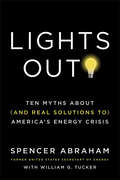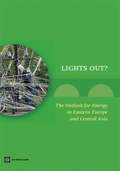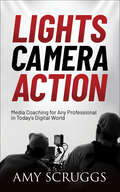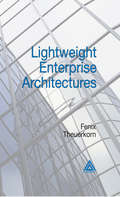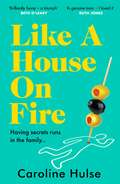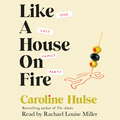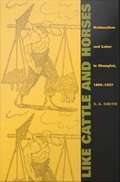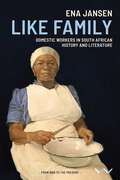- Table View
- List View
Light Manufacturing in Africa
by Hinh T. Dinh Vincent Palmade Vandana Chandra Frances CossarThis book argues that light manufacturing can offer a viable solution for Sub-Saharan Africa’s need for structural transformation and productive job creation, given its potential competitiveness based on low wage costs and an abundance of natural resources that supply raw materials needed for industries. Based on five different analytical tools and data sources, the book examines in detail the binding constraints in each of the subsectors relevant for Sub-Saharan Africa (SSA): apparel, leather goods, metal products, agri-business, and wood products. Ethiopia is used as an example, with Vietnam as a comparator and China as a benchmark, and with insights from Tanzania and Zambia used to draw out lessons more broadly for SSA. The book recommends a program of focused policies to exploit Africa’s latent comparative advantage in a particular group of light manufacturing industries – especially leather goods, garments, and agricultural processing. These industries hold the prospect of initiating rapid, substantial, and potentially self-propelling waves of rising output, employment, productivity, and exports that can push countries like Ethiopia on a path of structural change of the sort recently achieved in both China and Vietnam. The timing for these initiatives is very appropriate as China’s comparative advantage in these areas is diminishing due to steep cost increases associated with rising wages and non-wage labor costs, escalating land prices, and mounting regulatory costs. Five features of this book distinguish it from previous studies. First, the detailed work on light manufacturing at the subsector and product levels in five countries provide in-depth cost comparisons between Asia and Africa that can be used as a framework for future studies. Second, the book uses a wide array of quantitative and qualitative techniques to identify key constraints to enterprises and to evaluate firm performance differences across countries. Third, the findings that firm constraints vary by country, sector, and firm size led to a focused approach to identifying constraints and combining market-based measures and select government intervention to remove them. Fourth, the solution to light manufacturing problems cuts across many sectors: solving the manufacturing inputs problem requires solving specific issues in agriculture, education, and infrastructure. African countries cannot afford to wait until all the problems across sectors are resolved. Fifth, the book draws on experiences and solutions from other developing countries to inform its recommendations. This book will be very valuable to African policy makers, professional economists, and anyone interested in economic development, industrialization, and structural transformation of developing countries.
Light Pollution in Metropolises: Analysis, Impacts and Solutions
by Emlyn Etienne GoronczyLight pollution (light smog, light pollution or light emissions) is a fundamental problem in metropolises with effects on flora, fauna and people. Accordingly, the first section of the book discusses the basics of light pollution and its effects on various organisms. The characteristics of light smog in the cities of Hanover, Warsaw, Boston, New York City and Toronto are then analysed and compared. But how can the problem be tackled? Existing measures for the prevention of light pollution are discussed and further novel approaches are shown by comparing the metropolises. The book is aimed primarily at practitioners in this field and helps to identify sources of emissions and identify suitable reduction measures. This book is a translation of the original German edition „Lichtverschmutzung in Metropolen“ by Emlyn Etienne Goronczy, published by Springer Fachmedien Wiesbaden GmbH in 2018. The translation was done with the help of artificial intelligence (machine translation by the service DeepL.com). A subsequent human revision was done primarily in terms of content, so that the book will read stylistically differently from a conventional translation. Springer Nature works continuously to further the development of tools for the production of books and on the related technologies to support the authors.
Light Pollution: Responses and Remedies (The Patrick Moore Practical Astronomy Series)
by Bob MizonThere have been many developments in the field of light pollution over the last few years, and this second edition of 'Light Pollution - Responses and Remedies' will introduce them in detail. Examples include the appearance of anti-light pollution legislation in various countries, new departures in lighting design, human health implications, and the growing realization among the general public that lighting is not always a good thing. In this title, author Bob Mizon discusses the various ways in which wasted artificial light has damaged the quality of modern life, and suggest solutions. This book is for anyone who has experienced glare, discomfort, or nuisance from poorly directed lights; has wondered why we waste so much money lighting the sky; or anyone who simply wants to see the stars instead of a baleful urban glow. "Light Pollution, 2nd Edition" offers practical and inexpensive solutions to the world-wide problem of wasted artificial light, and emphasizes that light pollution is not just an astronomers' problem, but affects everyone in various ways.
Light a Fire in Their Hearts: The Truth About Leadership
by Lisa Anna PalmerA guide to being the best leader possible in business, or anywhere.Are you a manager or director climbing the ranks, a founder who’s busy growing your army, or a formal leader in any field? If yes, you need to retain talented employees and inspire them to contribute their very best at work using methods that go beyond command-and-control leadership. So, how do you get the competitive edge in today’s rapidly evolving workplace?In Light a Fire in Their Hearts, leadership expert Lisa Anna Palmer guides you through the leadership journey. She shares powerful stories and techniques drawn from over thirty great leaders—a team of virtual mentors who impart their wisdom how to:Understand the impact of leaders on people, the planet, and the bottom lineRaise your self-awareness and shift to a great people leader mindsetOvercome challenges not typically taught in business schoolUse the “Light Your Leadership” approach to tap into the top competitive advantage in twenty-first century businessUsing a fun-to-read, conversational style, this book provides modern leaders with a guide for lighting a fire in the hearts of employees, igniting engagement, and helping you and your company succeed.“Wonderful leadership book with a premise I love. To ignite employees’ passions and inspire them to be and do their best at work, you need to light a fire in their hearts. The world needs more of this right now.” —Marci Shimoff, #1 New York Times–bestselling author of Happy for No Reason
Light and Liberty: Thomas Jefferson and the Power of Knowledge (Jeffersonian America)
by Robert M.S. McDonaldAlthough Thomas Jefferson’s status as a champion of education is widely known, the essays in Light and Liberty make clear that his efforts to enlighten fellow citizens reflected not only a love of learning but also a love of freedom. Using as a starting point Jefferson's conviction that knowledge is the basis of republican self-government, the contributors examine his educational projects not as disparate attempts to advance knowledge for its own sake but instead as a result of his unyielding, almost obsessive desire to bolster Americans’ republican virtues and values.Whether by establishing schools or through broader, extra-institutional efforts to disseminate knowledge, Jefferson's endeavors embraced his vision for a dynamic and meritocratic America. He aimed not only to provide Americans with the ability to govern themselves and participate in the government of others but also to influence Americans to remake their society in accordance with his own principles.Written in clear and accessible prose, Light and Liberty reveals the startling diversity of Jefferson’s attempts to rid citizens of the ignorance and vice that, in the view of Jefferson and many contemporaries, had corroded and corrupted once-great civilizations. Never wavering from his faith that "knowledge is power," Jefferson embraced an expansive understanding of education as the foundation for a republic of free and responsible individuals who understood their rights and stood ready to defend them.
Light and Power for a Multiracial Nation
by Julia Tischler'Modernisation' was one of the most pervasive ideologies of the twentieth century. Focusing on a case study of the Kariba Dam in central-southern Africa and based on an array of primary sources and interviews the book provides a nuanced understanding of development in the turbulent late 1950s, a time when most colonies moved towards independence.
Lighting a Spark: Inspiring and Being Inspired by Others and Practicing the Art of Possibility
by Rosamund Stone Zander Benjamin ZanderIn the Middle Ages, when lighting a fire from scratch was an arduous process, people often carried a metal box containing a smoldering cinder, kept alight throughout the day with little bits of kindling. This meant that a man could light a fire with ease wherever he went, because he always carried the spark. But our universe, according to the authors, is alive with sparks. We have at our fingertips an infinite capacity to generate a spark of possibility for others to share, and this practice, the practice of enrollment, is the subject of this chapter. Enrollment is not about forcing or tricking someone into doing something your way--it is about tapping into the basic human urge to connect, express, and communicate through passionate energy. This chapter was originally published as Chapter 9 of "The Art of Possibility: Transforming Professional and Personal Life."
Lighting the Fire: Crafting and Delivering Broadly Inspiring Messages
by Tom Ryder Tsedal Neeleynote
Lighting the Way at the Manor House Hotel
by Samuel G. Hanson Joel L. Heilprin Charles AndersenCase
Lighting the World: Transforming Our Energy Future by Bringing Electricity to Everyone
by Jim Rogers Stephen P. WilliamsA former power company executive “makes his provocative case for powering up the Third World” (Discover).Without electricity, everything is harder. Imagine no cell phones, refrigerators, kitchen lights, or radios. Imagine having to finish all the day’s tasks—cooking, working, cleaning—before the sun goes down. Your children couldn’t do homework; you couldn’t read. It seems unthinkable today, yet this is how a staggering number of people on Earth still live. But Jim Rogers believes that can soon change—transforming not only people’s daily lives, but also their hopes for the future.In Lighting the World, Rogers describes how an international coalition can come together to secure financing, spearhead the newest and cleanest technologies, and work with the governments, entrepreneurs, and NGOs already on the ground to ensure that everyone has access to a steady and reliable supply of power. In today’s competitive world, Rogers believes, that shouldn’t be an accidental privilege, but a fundamental human right.Praise for Lighting the World“A passionate, but not ideological, argument that offers a practical approach to solving real problems.” —Kirkus Reviews“An enthusiastic account and a great starting point for readers curious about sustainable, worldwide electricity.” —Library Journal“In Lighting the World, Jim Rogers treats us to two books in one: a gripping journey around the dramatic world of energy for the poor combined with a fascinating account of what it takes to run and innovate a major U.S. utility.” —Dan Kammen, Professor of Energy, Energy and Resources Group & Goldman School of Public Policy, University of California
Lighting up the Blackbox — Digital Transformation in German Lobbying (Gabler Theses)
by Kathrin KuhnDigital transformation, alongside social media channels, influences policymaking. The aim of this research is to build knowledge of the consequences of digital transformation on lobbying at German federal level. This analysis uncovers how digital lobbying works in Germany and how it changes classic lobbying communication within the political sphere. Taking a grounded theory approach, the study addresses both communicating sides: lobbyists, on the one hand, and members of the German Bundestag and their employees, on the other. A profound understanding of, and differentiation between, lobbying and digital lobbying is gained through a first data-gathering step of 15 interviews with representatives of both the political and lobbying sides. The study extends previous analyses by supplementing the findings with ethnographic data from the researcher’s experience of working as an employee of a member of the German Bundestag. Final conclusions were drawn by presenting these results in the second data-gathering step, during four (digital) focus groups with the political side and three with agency, association, and corporate lobbyists from Berlin. The analysis uncovers a power shift in lobbying communication and a novel communication direction.
Lightning Discharges: Formation, Terminologies, Measurements and Theory (SpringerBriefs in Applied Sciences and Technology)
by Pitri Bhakta Adhikari Aashutosh AdhikariThis book highlights the basic information about lightning. It is an unpredictable disaster, and it is an extremely complex electrical discharge phenomenon. A complete theory of lightning does not exist till now. This book elaborates on the basic formation of lightning, terminologies related to lightning, and the preliminary lightning theory. There are different types of lightning, such as cloud flashes, ground flashes (both positive and negative), and air discharges. This book explains some unusual events related to lightning and inspects innovation. This book also describes the measurement of electric and magnetic fields generated by lightning, which are the basic parameters for lightning fundamentals.
Lightning Strategies for Innovation
by Willard I. ZangwillHow the World's Best Firms Create New Products.
Lightning in a Bottle: The Proven System to Create New Ideas and Products That Work
by David Minter Michael ReidLightning in a Bottle presents a simple seven-step system for creating ideas that work--one that improves new-product success rates from the standard one in 10 to one in two or better. Lightning in a Bottle also explains the top 10 reasons ideas fail, plus the dirty secrets of the research world, such as: -Why focus groups don't work for new products; -How market segmentation is often a sham; -Why brainstorming in not effective in creating great new products. In the tradition of Execution and Good to Great, Lightning in a Bottle is the new must-have guide for business leaders.
Lightning: Science, Engineering, and Economic Implications for Developing Countries (Lecture Notes in Electrical Engineering #780)
by Chandima GomesThis book highlights the essential theoretical and practical aspects of lightning, lightning protection, safety and education. Additionally, several auxiliary topics that are required to understand the core themes are also included. The main objective of the contents is to enlighten the scientists, researchers, engineers and social activists (including policy makers) in developing countries regarding the key information related to lightning and thunderstorms. A majority of developing countries are in tropics where the lightning characteristics are somewhat different from those in temperate regions. The housing structures and power/communication networks, and human behavioural patterns(that depends on socio-economic parameters) in these countries are also different from those in the developed world. As the existing books on similar themes address only those scenarios in developed countries, this book serves a vast spectrum of readership in developing world who seek knowledge in the principles of lightning and a practical guidance on lightning protection and safety education.
Lights Out!: Ten Myths About (and Real Solutions To) America's Energy Crisis
by Spencer Abraham William Guise TuckerIn this timely book, former Secretary of Energy Spencer Abraham debunks the myths that warp our current debate over energy, and offers new solutions to the real problems we face in America. Drawing on the very latest thinking from experts in industry and academia, and his own experiences running America's Energy Department, he proposes a fresh approach to meeting our daunting energy threats. This book effectively answers how America and the world can overcome the challenges of rising global energy demand, geopolitical disruptions of the energy marketplace, and the environmental impact of producing and using energy. What emerges is a pragmatic energy strategy that calls for blending a variety of energy sources including nuclear, clean coal, solar, wind, and natural gas with a more determined effort at improving energy efficiency through the deployment of smart energy grids and buildings, to help meet our challenges while preserving our economy and environment. Coming in the midst of a national debate about global warming, energy dependence and rising energy prices and rich with anecdotes from the author's service in the Senate and cabinet, this book is a clarion call that will help shape our energy future.
Lights Out: Pride, Delusion, and the Fall of General Electric
by Thomas Gryta Ted MannHow could General Electric—perhaps America&’s most iconic corporation—suffer such a swift and sudden fall from grace? This is the definitive history of General Electric&’s epic decline, as told by the two Wall Street Journal reporters who covered its fall. Since its founding in 1892, GE has been more than just a corporation. For generations, it was job security, a solidly safe investment, and an elite business education for top managers. GE electrified America, powering everything from lightbulbs to turbines, and became fully integrated into the American societal mindset as few companies ever had. And after two decades of leadership under legendary CEO Jack Welch, GE entered the twenty-first century as America&’s most valuable corporation. Yet, fewer than two decades later, the GE of old was gone. Lights Out examines how Welch&’s handpicked successor, Jeff Immelt, tried to fix flaws in Welch&’s profit machine, while stumbling headlong into mistakes of his own. In the end, GE&’s traditional win-at-all-costs driven culture seemed to lose its direction, which ultimately caused the company&’s decline on both a personal and organizational scale. Lights Out details how one of America&’s all-time great companies has been reduced to a cautionary tale for our times.
Lights Out: Ten Myths About (and Real Solutions to) America's Energy Crisis
by Spencer Abraham William G. TuckerIn this timely book, former Secretary of Energy Spencer Abraham debunks the myths that warp our current debate over energy, and offers new solutions to the real problems we face in America. Drawing on the very latest thinking from experts in industry and academia, and his own experiences running America's Energy Department, he proposes a fresh approach to meeting our daunting energy threats. This book effectively answers how America and the world can overcome the challenges of rising global energy demand, geopolitical disruptions of the energy marketplace, and the environmental impact of producing and using energy. What emerges is a pragmatic energy strategy that calls for blending a variety of energy sources including nuclear, clean coal, solar, wind, and natural gas with a more determined effort at improving energy efficiency through the deployment of smart energy grids and buildings, to help meet our challenges while preserving our economy and environment. Coming in the midst of a national debate about global warming, energy dependence and rising energy prices and rich with anecdotes from the author's service in the Senate and cabinet, this book is a clarion call that will help shape our energy future.
Lights Out? The Outlook for the Energy Sector in Eastern Europe and the Former Soviet Union
by World BankEmerging Europe and Central Asia, the region made up of the countries of Central and South East Europe (CSE) and the Commonwealth of Independent States (CIS), is a major energy supplier to both Eastern and Western Europe. However, the outlook for both primary and derivative energy supplies is questionable, with a real prospect that there will be a significant decline during the next two decades. Western Europe is heavily dependent on energy imports from this region and therefore will be affected by declines in primary energy supplies. But Western Europe has the financial capacity to secure the energy supplies it needs (albeit at the expense of others). In contrast, the region's energy-importing countries are caught between Western Europe, which has increasing import needs, and it's own exporters, whose exports will likely decline. These countries face the prospect of being squeezed not only financially but also in terms of energy access. This difficult prospect is compounded by the deterioration of the energy infrastructure, including power generation and district heating. Although the public sector will have to finance a portion of these infrastructure investments, it will not have the capacity to meet the full needs. It is essential, therefore, that the countries in the region move quickly to put in place an enabling environment to support investment in the sector. Further complicating these issues are environmental concerns, in particular concern about climate change. EU member states and those with EU ambitions will need to meet the challenging EU greenhouse gas emissions targets. At the same time, a number of countries in the region will face the temptation to use environmentally unfriendly technology to meet their immediate energy needs. 'Lights Out?' analyzes key measures that can help countries address all of these challenges.
Lights, Camera, Action: Media Coaching for Any Professional in Today's Digital World
by Amy ScruggsOn-camera insecurities and fears are common for many professionals and can keep them from growing their confidence and their business through the power of the media. Lights, Camera, Action gives practical advice and techniques to help achieve on-camera and communication skills to be a leader in today’s virtual world. After completing Lights, Camera, Action, readers will know how to deliver a concise message and be confident and ready for the various media platforms including Network TV interviews, podcasts and video marketing. They will also be ready to stand out in their virtual meetings with their introduction and messaging skills. Readers will be ready to utilize media opportunities for growth and visibility for their business of any industry.
Lightweight Enterprise Architectures
by Fenix TheuerkornThe author developed Lightweight Enterprise Architecture (LEA) to enable a quick alignment of technology to business strategy. LEA's simple and effective framework makes it useful to a wide audience of users throughout an enterprise, coordinating resources for business requirements and facilitating optimal adoption of technology. Lightweight Enterprise Architectures provides a methodology and philosophy that organizations can easily adopt, resulting in immediate value-add without the pitfalls of traditional architectural styles. This systematic approach uses the right balance of tools and techniques to help an enterprise successfully develop its architecture. The first section of the text focuses on how enterprises deploy architecture and how architecture is an evolving discipline. The second section introduces LEA, detailing a structure that supports architecture and benefits all stakeholders. The book concludes by explaining the approach needed to put the framework into practice, analyzing deployment issues and how the architecture is involved throughout the lifecycle of technology projects and systems. This innovative resource tool provides you with a simpler, easily executable architecture, the ability to embrace a complex environment, and a framework to measure and control technology at the enterprise level.
Like A House On Fire: ‘Brilliantly funny - I loved it' Beth O'Leary, author of The Flatshare
by Caroline Hulse'A joyously wicked read that will cheer you up no end. A genuine tonic. So clever, so funny and so refreshingly different. I loved it' RUTH JONES'Warm, witty & brilliantly realised' DAILY MAIL'Part Fleabag, part Agatha Christie' JOSIE SILVERTwo people trying to break up.One last family party.And no way out of it...* * * * *Things Stella and George have had blazing rows about:- Misquoting Jurassic Park.- Leaving a Coke can on the side of the bath.- Fitting car seats for their hypothetical kids.In other news, they're getting divorced.But first, Stella's mum is throwing a murder mystery party and - with her dad losing his job, her mum's recent diagnosis, and some very odd behaviour from her sister - now is not the time to tell everyone.All Stella and George have to do is make it through the day without their break-up being discovered - though it will soon turn out that having secrets runs in the family...* * * * *Praise for LIKE A HOUSE ON FIRE:'When it comes to personal relationships, Caroline Hulse dares to show us what we humans are really like. Her sparkling dialogue, astute observations and gloriously irreverent humour make Like A House On Fire a joyously wicked read that will cheer you up no end. A genuine tonic. So clever, so funny and so refreshingly different. I loved it' RUTH JONES'Acutely observed and brilliantly funny' CLARE MACKINTOSH'Funny and sad and relatable and deeply human' HARRIET TYCE'Part Fleabag, part Agatha Christie, Like A House On Fire is everything I love in a book...I was hooked from page one. Bravo, what a triumph!' JOSIE SILVER'Sheer delight from start to finish' LESLEY KARA'Painfully astute and brilliantly funny' BETH O'LEARY'Witty, whip-smart and wincingly observant, pure entertainment from start to finish. A Caroline Hulse book is a reading highlight of my year' CATHY BRAMLEY'Absolutely loved Like A House On Fire. A proper delight' RICHARD ROPER'Hilarious and brilliant and clever in that way only Caroline knows how to be. So compelling, I couldn't put it down' LUCY VINE'Caroline Hulse is a very funny writer and a wonderfully compassionate observer of human frailty' KATE EBERLEN'Funny, moving and astute. A triumph!' NICOLA MOSTYN
Like A House On Fire: ‘Brilliantly funny - I loved it' Beth O'Leary, author of The Flatshare
by Caroline Hulse'Joyously wicked... I loved it' RUTH JONES'Warm, witty & brilliantly realised' DAILY MAIL'Part Fleabag, part Agatha Christie' JOSIE SILVERALL STELLA AND GEORGE HAVE TO DO IS...Hide their breakupAfter a series of blazing rows about everything from Jurassic Park to installing car seats for their (hypothetical) children, Stella and George are getting divorced.Catch a murderer*But first, Stella's mum is throwing a murder mystery party - and with her dad losing his job and her mum's recent diagnosis, now is hardly the time to tell everyone.Make it through one last family partyStella and George just have to get through the day without their breakup being discovered - though it will soon turn out that keeping secrets runs in the family...*pretend murderer* * * * *Praise for LIKE A HOUSE ON FIRE:'When it comes to personal relationships, Caroline Hulse dares to show us what we humans are really like. Her sparkling dialogue, astute observations and gloriously irreverent humour make Like A House On Fire a joyously wicked read that will cheer you up no end. A genuine tonic. So clever, so funny and so refreshingly different. I loved it' RUTH JONES'Part Fleabag, part Agatha Christie, Like A House On Fire is everything I love in a book' JOSIE SILVER'Painfully astute and brilliantly funny' BETH O'LEARY'A deliciously dark comedy of manners' DAILY EXPRESS'Acutely observed... Very Nina Stibbe' CLARE MACKINTOSH'Funny and sad and relatable and deeply human' HARRIET TYCE
Like Cattle and Horses: Nationalism and Labor in Shanghai, 1895-1927
by S. A. SmithIn Like Cattle and Horses Steve Smith connects the rise of Chinese nationalism to the growth of a Chinese working class. Moving from the late nineteenth century, when foreign companies first set up factories on Chinese soil, to 1927, when the labor movement created by the Chinese Communist Party was crushed by Chiang Kai-shek, Smith uses a host of documents--journalistic accounts of strikes, memoirs by former activists, police records--to argue that a nationalist movement fueled by the effects of foreign imperialism had a far greater hold on working-class identity than did class consciousness. While the massive wave of labor protest in the 1920s was principally an expression of militant nationalism rather than of class consciousness, Smith argues, elements of a precarious class identity were in turn forged by the very discourse of nationalism. By linking work-related demands to the defense of the nation, anti-imperialist nationalism legitimized participation in strikes and sensitized workers to the fact that they were worthy of better treatment as Chinese citizens. Smith shows how the workers' refusal to be treated "like cattle and horses" (a phrase frequently used by workers to describe their condition) came from a new but powerfully felt sense of dignity. In short, nationalism enabled workers to interpret the anger they felt at their unjust treatment in the workplace in political terms and to create a link between their position as workers and their position as members of an oppressed nation. By focusing on the role of the working class, Like Cattle and Horses is one of very few studies that examines nationalism "from below," acknowledging the powerful agency of nonelite forces in promoting national identity. Like Cattle and Horses will interest historians of labor, modern China, and nationalism, as well as those engaged in the study of revolutions and revolt.
Like Family: Domestic workers in South African history and literature
by Ena JansenAn analytic and historical perspective of literary texts to understand the position of domestic workers in South AfricaMore than a million black South African women are domestic workers. Precariously situated between urban and rural areas, rich and poor, white and black, these women are at once intimately connected and at a distant remove from the families they serve. Ena Jansen shows that domestic worker relations in South Africa were shaped by the institution of slavery, establishing social hierarchies and patterns of behavior that persist today. To support her argument, Jansen examines the representation of domestic workers in a diverse range of texts in English and Afrikaans. Authors include André Brink, JM Coetzee, Imraan Coovadia, Nadine Gordimer, Elsa Joubert, Antjie Krog, Sindiwe Magona, Kopano Matlwa, Es'kia Mphahlele, Sisonke Msimang, Zukiswa Wanner and Zoë Wicomb. Like Family is an updated version of the award-winning Soos familie (2015) and the highly-acclaimed 2016 Dutch translation, Bijna familie.
